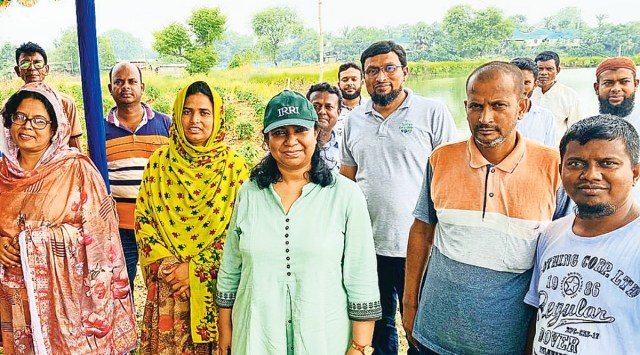Borlaug award winner’s fieldwork: How to close the tech gap and help farmers
Nayak’s work – as South Asia head for Seed System and Product Management at the International Rice Research Institute (IRRI) – has been on “technology scaling” or closing the gap between scientific knowledge and its practical application among farmers.
 Swati Nayak is credited with the successful dissemination and adoption of over 20 climate-resilient rice varieties
Swati Nayak is credited with the successful dissemination and adoption of over 20 climate-resilient rice varieties “There are about 1,500 rice varieties that have been released or developed in India, but only 350-400 are indented by seed producers/suppliers. Even out of those, the demand is for hardly 50 varieties, with the rest just on paper and never hitting farmers’ fields,” says Swati Nayak, winner of this year’s Norman E Borlaug Award for Field Research and Application.
The 39-year-old recipient of the prestigious award of the World Food Prize Foundation is upfront about not being a plant breeder or geneticist. She completed a Bachelor of Science in Agriculture from the Acharya N G Ranga Agricultural University, Hyderabad in 2007, “but had no interest in taking up a masters or PhD and decided only to do something that was application-based”.
Nayak’s work – as South Asia head for Seed System and Product Management at the International Rice Research Institute (IRRI) – has been on “technology scaling” or closing the gap between scientific knowledge and its practical application among farmers.
The varieties developed by public sector agricultural research institutions/universities are maintained as genetically pure “nucleus” or “breeder seeds”. The breeder seeds are multiplied in about 1:80 ratio into “foundation seeds” by the National Seeds Corporation, State Farms Corporation of India and various state seed companies. The foundation seeds are further multiplied in a similar ratio, mostly on the farms of progressive growers, into “certified seeds”. It is the last that is commercially sown and saved from harvested grain by farmers.
“The early-generation (nucleus and breeder) seeds of any new variety need to be available in sufficient quantity and on time to enable faster multiplication. This has to be accompanied by showcasing of the variety and evaluation under farmer-managed conditions, while involving all stakeholders (farmers, seed producers, dealers and extension workers). And we need to do these on scale for good varieties to reach farmers’ fields,” Nayak points out.
Currently, breeders and farm extension wings of the government “work in silos” and it is necessary to “integrate the two verticals,” she says.
Nayak – she did a masters from the Institute of Rural Management Anand and worked with the Integrated Tribal Development Agency at Seethampeta in Andhra Pradesh’s Srikakulam district, before joining IRRI in 2013 – is credited with the successful dissemination and adoption of more than 20 climate-resilient and bio-fortified rice varieties.
Among these are ‘Sahbhagi Dhan’, a drought-tolerant variety suitable for hilly uplands, and ‘BINA Dhan-11’, which is flood-tolerant. Nayak and her team formulated a strategy for introducing ‘Sahbhagi Dhan’ in the tribal belt of Odisha’s Mayurbhanj district, encompassing setting up demonstration plots, on-farm evaluation and seed production by women farmers. The cascading effect was borne out by ‘Sahbhagi Dhan’ becoming a much in-demand variety throughout Odisha.
‘BINA-Dhan-11’, which contains a submergence-tolerant Sub1 gene identified from an indigenous land race of Odisha, was a similar success story of adoption in Nayak’s home state as well as Assam. The Sub1 gene has been incorporated into many existing popular high-yielding varieties such as ‘Samba Mahsuri’, ‘Swarna’ and ‘Ranjit’. There are, likewise, other drought-tolerant varieties such as ‘DRR Dhan 42’ and ‘DRR Dhan 44’.
Taking all these varieties from lab to land – in a swift and equitable manner – is a challenge that Nayak has sought to address that few breeders have.








